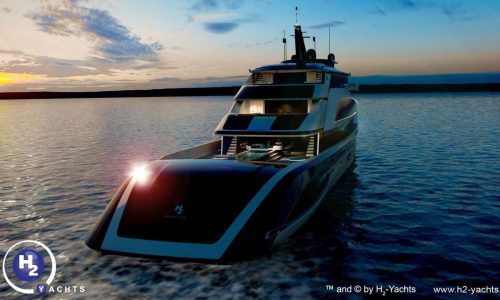H2 Yachts reveals world’s first energy autonomous superyacht

H2-Yachts, a division of the Switzerland based H2-Industries AG, has developed the world’s first energy autonomous superyacht. The propulsion system is fully electric and has a liquid organic hydrogen carrier (LOHC) as the energy storage and a minimum effort on maintenance for all systems. Mallorca-based naval architect Michael Stusch has worked on this concept for over four years.
To combine solar panels in a modern clean hull and superstructure design was the goal of Michael Stusch. With over 20 year’s maritime experience as a captain, Michael was the engineer responsible for the naval architecture of the yacht; the exterior and interior design was developed by the Austria-based design team Motion Code: Blue.
The vertical bow and explorer form allows for a 480m² beach club with two waterfall pools across two decks and a 100 m² fold-out bathing platform. The bedroom opens onto the private terrace and boasts a bow and stern terrace, with spa, sauna, steam bath and whirlpool.
The bridge deck is used as a dining area which seats 16 and includes a bar, wood fire pig roast and wood fire pizza oven.
The tender housing allows for two customised tenders and an SUV car are located underneath the lower beach club, around the pool. The fold-out side flaps increases the size of the lower beach club and are used as docking platforms for the tenders and other water toys.
The 7.5 meter high bow not only gives thef yacht stability in heavy seas, but also enables more space for tenders, jet skis or a small helicopter hangar.
Besides the electrical Voith-Schneider Propellers for silent cruising, with full stabilisation and dynamic positioning, the tank deck is equipped with all the necessary yacht equipment and a crew mess with a pantry for three chefs.
The rest of the space is used for the 250,000 liter “Liquid Organic Hydrogen Carrier” tanks. This “fuel” is a liquid when under normal pressure and temperature; the hydrogen will be extracted from the liquid to supply the fuel cells. The LOHC amount will always remain the same, a large advantage for yachts.
The yacht tops up on anchor with its 850m² solar panels, which makes the yacht energy autonomous with a reach of over 5,000 nm.
Source: Yachting Pages